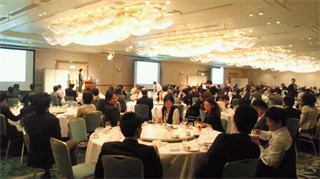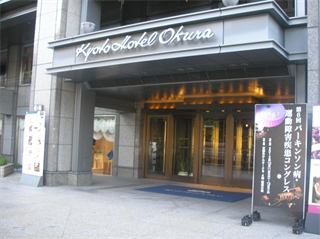Sixth Annual Meeting of Movement Disorder Society of Japan
Course Report
The 6th Congress of Parkinson’s Disease and Movement Disorders, Movement Disorder Society of Japan, took place at Kyoto Hotel Okura in Kyoto, Japan on October 11-13, 2012 (Fig 1). There were 762 people who came together to network and to learn about the latest research and perspectives in the field of Movement Disorders. In addition to neurologists, many neuroscientists, rehabilitation doctors, neurosurgeons participated in it. Several PD patients also took part in the meeting. The followings sessions were held:
- 8 Opening seminars
- 3 symposia
- 2 Educational lectures
- 1 Video Session
- 3 Controversies
- 1 Evening Video session
- 3 Luncheon seminars
- 2 Poster sessions
 In one luncheon seminar, Professor Angelo Antonini, University of Padua Italy, gave us a lecture entitled “Current Treatment of Parkinson’s disease 2012”. He summarized the present strategy to treat Parkinson’s disease patients and showed some new trails of Parkinson’s disease treatments. Several basic neuroscience talks gave us, neurologists, hint for future researches.
In one luncheon seminar, Professor Angelo Antonini, University of Padua Italy, gave us a lecture entitled “Current Treatment of Parkinson’s disease 2012”. He summarized the present strategy to treat Parkinson’s disease patients and showed some new trails of Parkinson’s disease treatments. Several basic neuroscience talks gave us, neurologists, hint for future researches.
In one teaching session, we used MDS educational slides “Classification and Phenomenology of Movement Disorders” for the first time. It presented many videos of typical involuntary movements. The flow chart of how to see patients with involuntary movements shown in the session should have taught young neurologists neurological examination tactics for movement disorders.
 One big event of the meeting is the “evening video session”. In this session, participants studied how to see patients with involuntary movements viewing many videos from various institutes or hospitals at dinner (Fig2).
One big event of the meeting is the “evening video session”. In this session, participants studied how to see patients with involuntary movements viewing many videos from various institutes or hospitals at dinner (Fig2).
All 18 videos shown this year were interesting and attractive. We selected three videos as Japanese representative videos for MDS meeting in Sydney next year.
The meeting was both successful and fascinating.






